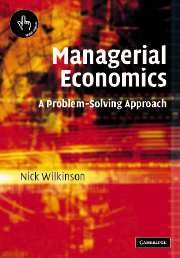Chapter 2 - The theory of the firm
Published online by Cambridge University Press: 05 June 2012
Summary
Objectives
To introduce and define the concept of the firm and its nature.
To discuss various methods for undertaking business transactions.
To compare the advantages and disadvantages of using the market rather than internalizing transactions within the firm.
To explain the nature of transaction costs.
To introduce the concept of the profit-maximizing model.
To describe the various assumptions which frequently underlie the profit-maximizing model and explain why they are made.
To explain the limitations of the basic profit-maximizing model.
To consider the nature of the agency problem in terms of how it affects firms' objectives.
To consider the problems associated with the measurement of profit, and the implications for objectives.
To consider the nature of the shareholder-wealth profit-maximizing model and its limitations.
To consider the implications of risk and uncertainty as far as objectives are concerned.
To consider multiproduct firms and the implications for objectives.
To summarize the strengths and weaknesses of the profit-maximizing model in comparison with other models.
Introduction
The neoclassical theory of the firm is sometimes called a ‘black box’. What this means is that the firm is seen as a monolithic entity; there is no attempt to probe inside the box and explain why firms exist in the first place, or how the individuals who constitute firms are motivated and interact. Therefore, before examining business objectives, it is necessary to address these more fundamental issues. Sometimes these aspects are omitted from courses in managerial or business economics, since they can be viewed as aspects of organizational behaviour.
- Type
- Chapter
- Information
- Managerial EconomicsA Problem-Solving Approach, pp. 20 - 70Publisher: Cambridge University PressPrint publication year: 2005



